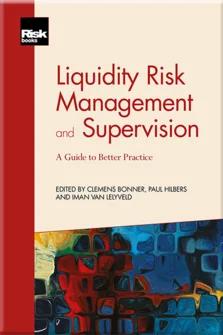Introduction to ‘Liquidity Risk Management and Supervision’
Introduction to ‘Liquidity Risk Management and Supervision’
Liquidity Regulation, the 2007-9 Crisis and the Regulatory Response
Sources of Liquidity Risk: Theory and Empirical Evidence
The Process of Liquidity Supervision
How to Implement ILAAP: Lessons Learned at Rabobank
Liquidity Risk Management Strategy and Tolerance
Liquidity Buffer Management and Banks’ Counterbalancing Capacity
Bank-Level Liquidity Stress-Testing
Contingency Funding Plans
Liquidity Transfer Pricing
Intraday Liquidity Risk Management
Putting Liquidity Risk Management into a Wider Context
Macroprudential Liquidity Stress Tests
A Simple Macroprudential Liquidity Buffer
The 2007–9 financial crisis constituted the largest shock to the world financial system since the Great Depression in the 1930s. Financial crises tend to have common factors but also unique elements (see, for example, Reinhart and Rogoff 2008, 2009). Most financial crises are preceded by asset and credit booms, which, in turn, are fostered by accommodative monetary policy (see, for example, Bordo and Wheelock 2007a,b; Allen and Gale 2007; Allen et al 2009; Claessens and Kose 2013). The most severe crises seem to arise when favourable financial market conditions coincide with rapid expansion in financial innovation (Calomiris 1998).
Similar to many other crises, the 2007–9 financial crisis has its origins in the real estate market. Making a historical comparison, Calomiris (2009) argues that, just as in previous real estate-related crises, the 2007–9 financial crisis was the result of government policies incentivising excessive real estate risk-taking. According to (among others) Brunnermeier (2009), this was supported by low interest rates caused by the fear of deflation after the bursting of the Internet bubble.
Apart from these policy-related factors, two financial
Copyright Infopro Digital Limited. All rights reserved.
As outlined in our terms and conditions, https://www.infopro-digital.com/terms-and-conditions/subscriptions/ (point 2.4), printing is limited to a single copy.
If you would like to purchase additional rights please email info@risk.net
Copyright Infopro Digital Limited. All rights reserved.
You may share this content using our article tools. As outlined in our terms and conditions, https://www.infopro-digital.com/terms-and-conditions/subscriptions/ (clause 2.4), an Authorised User may only make one copy of the materials for their own personal use. You must also comply with the restrictions in clause 2.5.
If you would like to purchase additional rights please email info@risk.net











